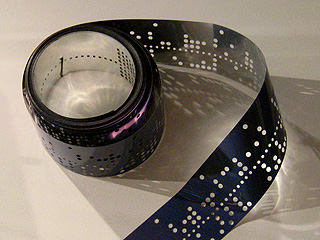
Life expectancy
The International Organization for Standardization (ISO) and the American National Standards Institute (ANSI) state that microfilm has a Life Expectancy (LE) of 500 years if the following ISO/ANSI guidelines are met:
- The microfilm is manufactured to the ISO and ANSI standards for LE-500 films.
- The microfilm must be processed according to ISO 18901:2002 Imaging Materials - Processed silver gelatin type black and white films - Specifications for stability. Meeting this standard is the responsibility of the microfilm processing facility.
- The microfilm must be stored according to ISO 18911:2000 Imaging Materials - Processed safety photographic films - Storage practices. Meeting this standard is the responsibility of the organization that stores the microfilm.
Source: Kodak. (2009). Kodak publication D-30: What is the life expectancy of microfilm? Retrieved February 25, 2011, from http://graphics.kodak.com/docimaging/uploadedFiles/techTip50.pdf
Deterioration
Microforms are most susceptible to damage by water. Wet microfilm must be immediately removed from enclosures and unrolled for air drying as it will stick to itself and any enclosures whilst drying.
Microfiche can be dried flat, emulsion side up, or clipped to a line by an image-free edge.
In the event of an emergency, use of the services of a local film processing lab is recommended. If microforms cannot be air-dried immediately, they must be immersed in clean, cold water and sent to a laboratory for safe washing and drying.
Wet microforms should not be frozen or freeze-dried since film layers may separate as a result and handling damage is difficult to prevent.
Diazo is prone to water spotting, and lint-free pads should be used to control beading. Moldy diazo and vesicular films may be cleaned with a slightly moistened lint-free pad. If mold infects silver gelatin-film, seek professional assistance.
Guidelines for meeting preservation standards include ANSI/Association for Information and Image Management (AIIM) standards, and specifications developed by the Research Libraries Group (RLG) and the Library of Congress.
Source: Northeast Document Conservation Center. (2000). Microfilm and microfiche. Retrieved February 25, 2011, from http://www.nedcc.org/resources/leaflets/6Reformatting/01MicrofilmAndMicrofiche.php